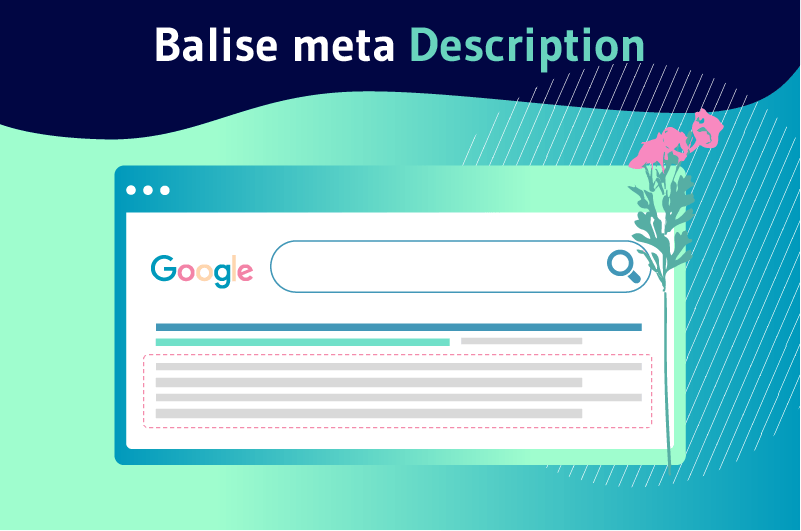A meta description tag is a short HTML attribute that adds an overview of the content of a page and is displayed below the title tag in search results. It is one of the most important elements presented to users for the query entered. It is presented as a snippet of your content and tells your potential visitors what kind of information they can find on your web page.
To give visitors in the SERPs a brief idea of the content of a website, a summary of the content must be presented.
This description is done and integrated in the HTML code thanks to the meta description markup.
If meta title helps readers to know the main topic of the content, meta description helps readers to clearly understand the content of the site.
So:
- What is a meta description tag and why is it important?
- What tool should I use to check this tag?
- What are the best practices to create it perfectly?
- Is it a ranking factor?
These are all questions and more that I will answer in this guide so you can find all the information you need in one place.
Let’s get started!
Chapter 1: The basics of a meta description
Here are the questions I will answer in this section:
- What is a meta description?
- Why is it important?
- What does it look like in different search engines?
- Where to add it on a web page?
Let’s start!
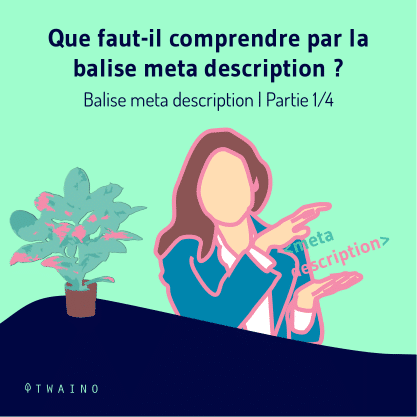





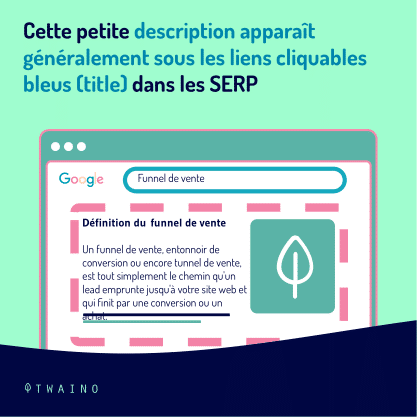



1.1 What is a meta description tag?
A meta description is a short extract of a specific page. This extract gives a clear idea of the content of the site. It usually appears under the blue clickable links in the search results

It also appears in the excerpts of articles and publications shared on social networks.
In SERPs, it gives users more information and helps them find answers to their questions. It is also an important decisive element for users to decide whether or not to click on a link in the SERPs.
In the HTML code, a meta description tag looks like this:
Example of a meta description:
Meta description in search results:

Its main function is to summarize the content of a particular page. The better your meta description is written, the more clicks it will generate.
1.2. Why is the use of the meta description tag important?
In this section, I will list three main benefits of using this tag:
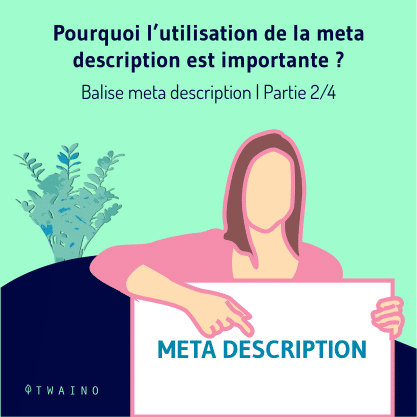


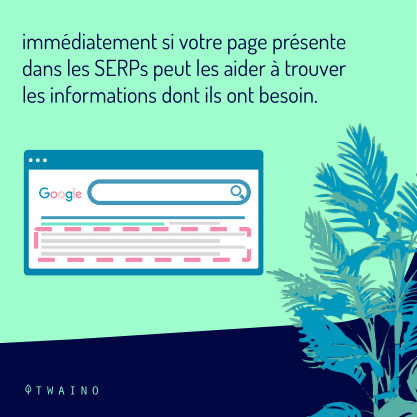
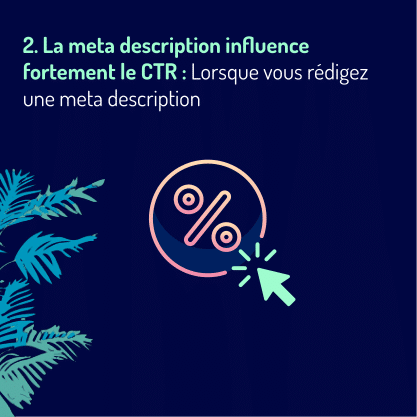





1.2.1. User experience
User experience is a criterion that matters a lot to search engines
When specified meta descriptions provide value to users, the benefits from an SEO perspective naturally follow.
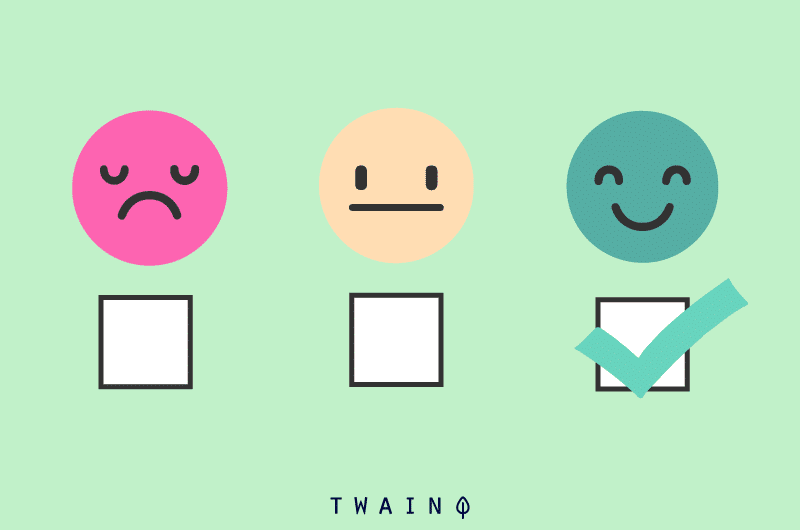
In fact, users want to find answers that perfectly match their query in the SERPs and you need to help them
To do this, you should write a meta description:
- Detailed
- Relevant ;
- And catchy
This way, they will immediately know if your page in the search results can help them find the information they need.
1.2.2. The meta description strongly influences the CTR
Meta descriptions strongly influence click-through rates or CTR, the percentage of users who clicked on a page
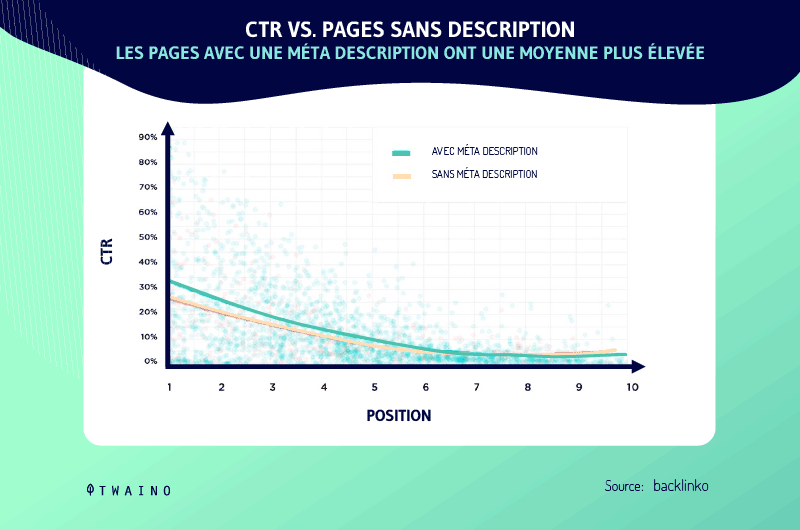
It is essentially your sales pitch, comparable to ad descriptions in Google AdWords.
When you write a relevant and compelling meta description that is packed with important information, you can easily convince users to click on your page

Thus, you increase the click-through rate, which leads to :
- More more visitors
- A higher conversion rate ;
- And finally, an increase in your revenue.
When the meta description is missing, too long or too short, search engines can produce a description of their own
This is often less perfect, and does not guarantee the quality to encourage users to visit your website.
1.2.3. More visits on social networks
In order to generate traffic from social networks, it is essential to use social media markup such as
- Facebook’s Open Graph ;
- Twitter Cards from Twitter
These tags are used to retrieve information such as title, description and images that should be displayed on social networks
Carefully choosing what social media platforms display when your page is shared can lead to more visitors.

However, if the social media markup is missing, the meta description is often used as a fallback
So, if you fail to use social media tagging, a good meta description will help drive traffic from social networks.
1.3. What does the meta description look like in different search engines?
Here are some examples of how they are displayed in Google, Bing and Yahoo SERPs on a desktop, after typing Twaino :
- In Google

- In Bing
- In Yahoo

1.4. Where to add a meta description on the page?
There are two ways to easily add this tag to your page.
- Add the meta description in the HTML code section of your site like this:
name=”description”
content=”Twaino SEO Agency helps you with your projects, with top of the line SEO services offered by seasoned SEO consultants.”
>
- Configure the meta description in your CMS:
If you use WordPress, the most common plugin is Yoast SEO. I think it’s the best plugin for SEO controlling meta tag and keyword settings on the page. I also use it on Twaino’s website.
Just write your text in the ” Meta description ” section, and it will show you what your code snippet will look like in the SERPs.
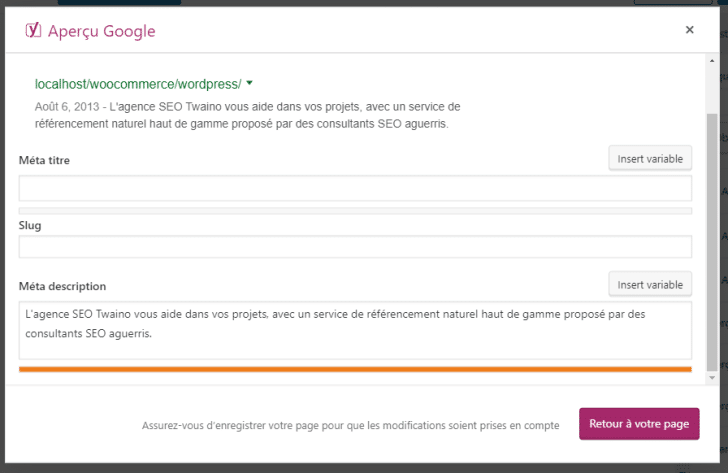
In fact, when you don’t specify this tag for your content, the search engines will do it for you themselves by taking a snippet from the web page
These search engines will automatically create the meta description by choosing a part of your content
1.5. Why does Google rewrite meta descriptions?


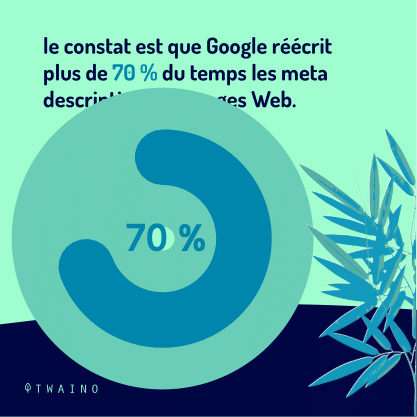


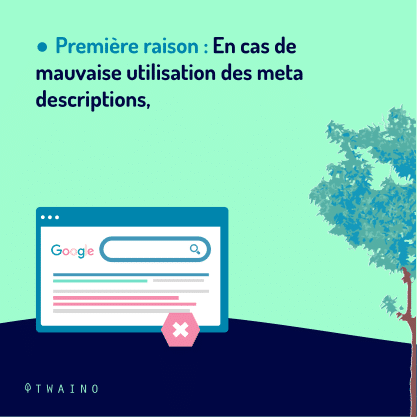


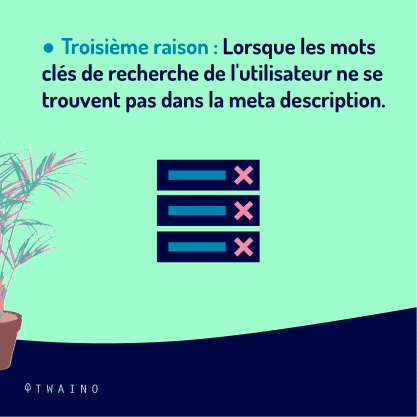

If you pay attention to Google’s results, you will probably notice that it proposes different excerpts for the same article depending on the queries
Not to mention that the description you give is not always the one that ends up being displayed.
According to a recent study on search results for 30,000 keywords, Google rewrites more than 70 % of the time the excerpts of web pages.
Also in the same context, Google rewrites them at a rate of :
Therefore, we can deduce that Google uses the original meta description of a page only 30% of the time.
You’re probably wondering why Google has a habit of rewriting them.
Google’s John Mueller provided three main reasons why Google does this:
- First reason: When meta descriptions are misused, i.e., for a purpose other than summarizing the page’s content;
- Second reason: When the content does not contain a part of the search query;
- Third reason: When the user’s search keywords are not found in the meta description.
So, is it relevant to add this tag knowing that it is not always used?
In my opinion, yes! Once the original version is sometimes displayed and this element allows you to reinforce your relevance on a given theme, you should take the trouble to add it.
Now, let’s see the best practices you should implement when creating your meta descriptions.
Chapter 2: Best practices to create a perfect meta description
Creating an attractive meta description is not an easy task. But I’m here to help you.
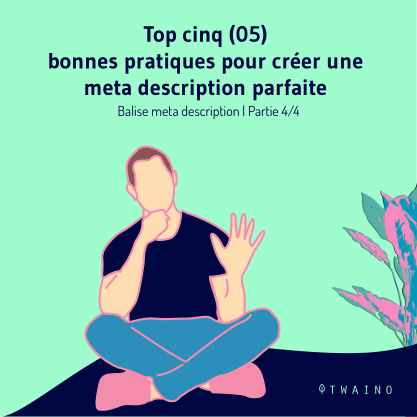


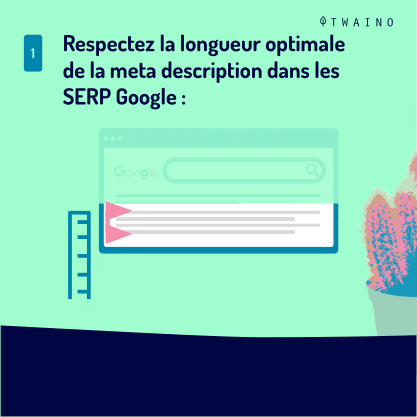






Imagine you are running a PPC campaign and you need to create the best ad with short text, exclamation points and click-through incentive.
Learning how to write good meta tags requires following some basic tips. The tips usually deal with the technical procedure.
Here are the main tips to follow to write a good meta description:
2.1. Respect the optimal length of meta description in Google SERPs
Search engines offer a limited space for the display of meta descriptions on SERPs. Therefore, it must be precise and summarize the subject of your page in two sentences at most
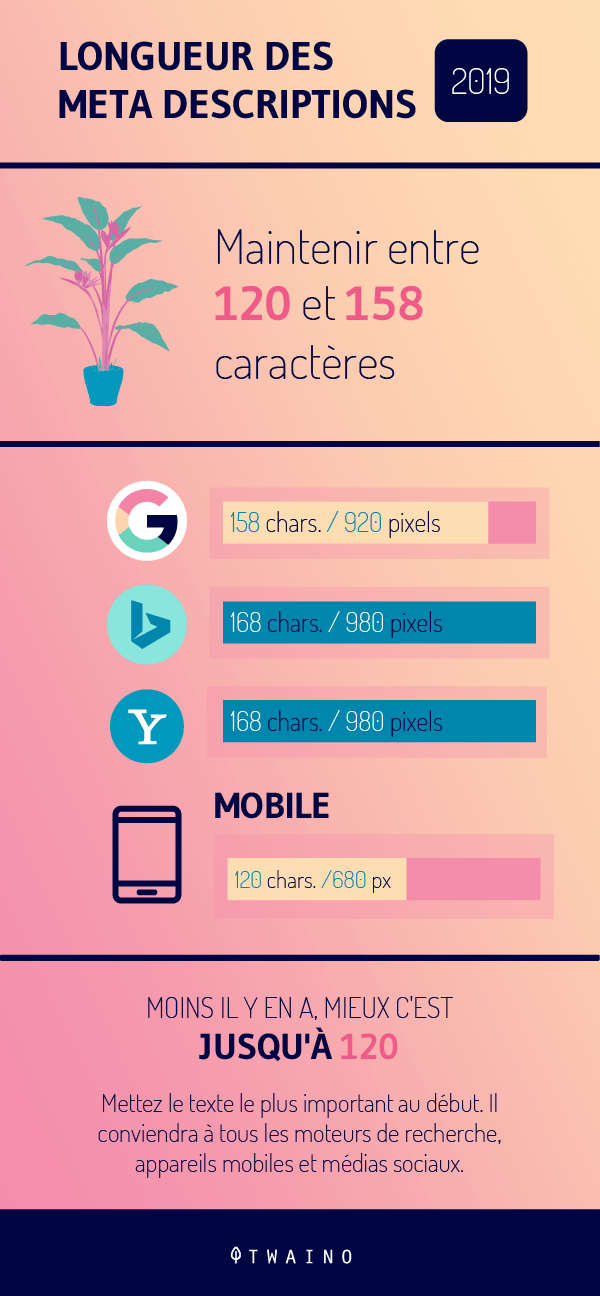
With 90 % of the global online search market, Google is the best search engine in the world. For this, I will mainly focus on the size of meta descriptions on Google SERPs
So we will see:
- The ideal length on desktop computers;
- The ideal length on mobile devices;
- And the ideal tool to check the length of meta descriptions.
2.1.1. Ideal meta description length on desktops
Almost everyone asks about meta description length, but the answer is a bit tricky.

The normal length of the description on desktop computers is between 600 and 960 pixels.
I say pixels because, the meta description depends on the length of the snippet in pixels and not the number of characters. The latter is not as important as the width in pixels.
Tip:
Your meta description should be simple, clear and catchy in order to stand out from the long snippets of results in the SERPs.
When writing it, you should use a tool to check the right length in pixels. You can do this by using the SERP Simulator simulator from twaino.
It doesn’t make sense to rely on a plugin or a tool that only measures a number of characters.
2.1.2. Ideal meta description length on mobile devices
Users are using more and more mobile devices to surf
When you take a look at statistics of Internet usage on mobile and computeryou will see that mobile usage in Europe has increased significantly between November 2019 and November 2020.
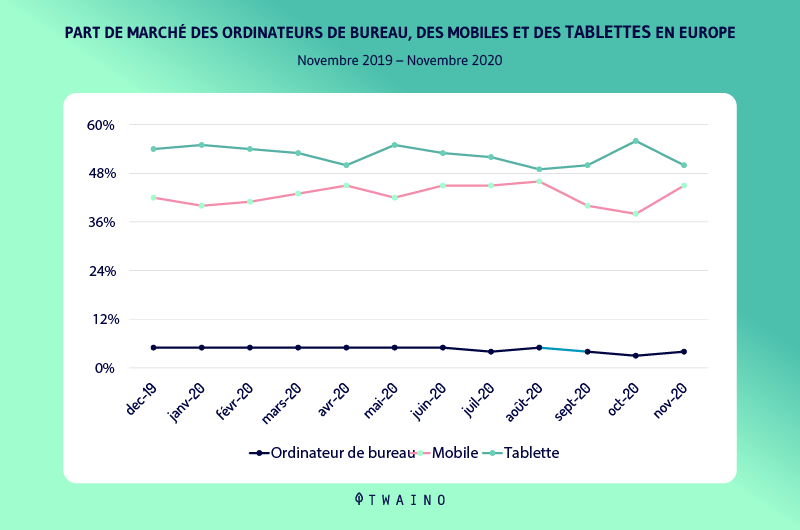
According to the chart above, the market share of desktop, mobile and tablet in Europe (November 2019 – November 2020) is:
- Desktop: 52.15%;
- Mobile: 44.64%;
- Tablet: 3.22%.
Optimizing the meta description tag for mobile devices is therefore essential. But keep in mind that the length on mobiles and tablets is shorter than on desktops.
Depending on the mobile device, these excerpts of can start from 100 to 230 characters. The best practice is to keep them under 120 characters.
Put all important information, including targeted keywords, at the beginning of the description.
2.1.3. Best tool to check the size of meta descriptions
As Google now calculates meta descriptions in pixels, you can use our Free SERP Simulator as a guide when creating your meta descriptions or titles
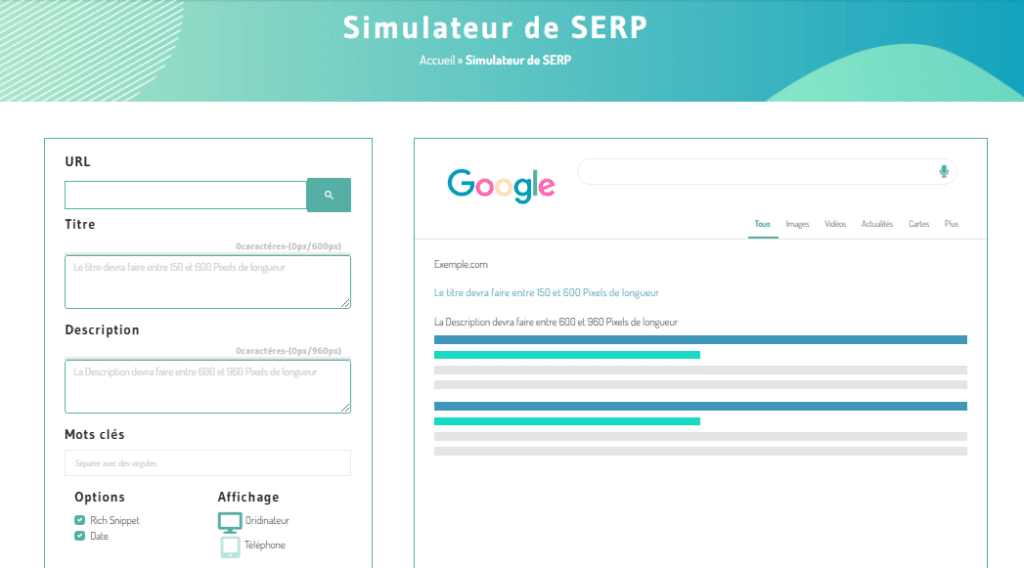
If you keep the length in pixels, your snippets will definitely fit in the SERPs, and you can be assured that all the important information in the meta tag will be indexed and shown to all users.
2.2. include a CTA
Your meta description should work for you. As the name suggests, it should be descriptive and written in a way that encourages clicks
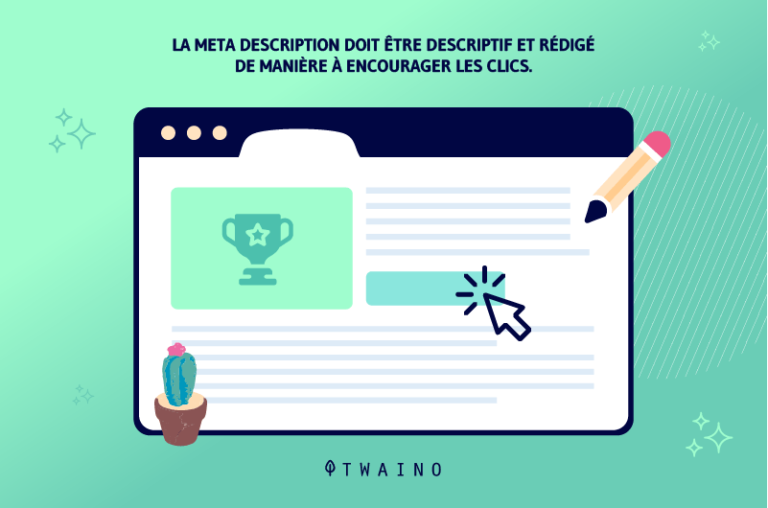
Most importantly, it should be promising and entice readers to click through to learn more
At the end of your content snippet, write ” Read more ” / ” See more ” or any other incentive that can increase clicks.
2.3. Use your main keywords in the meta descriptions and especially in a natural way
Even though search engines state that meta descriptions do not improve your ranking (which means that incorporating keywords is not mandatory), write them anyway.
As you can see in the screenshot below, when you type a particular phrase into a Google search box, such as create a logo online, you will get a list of results with all the keywords appearing in bold
This usually refers to the keywords in the meta descriptions.
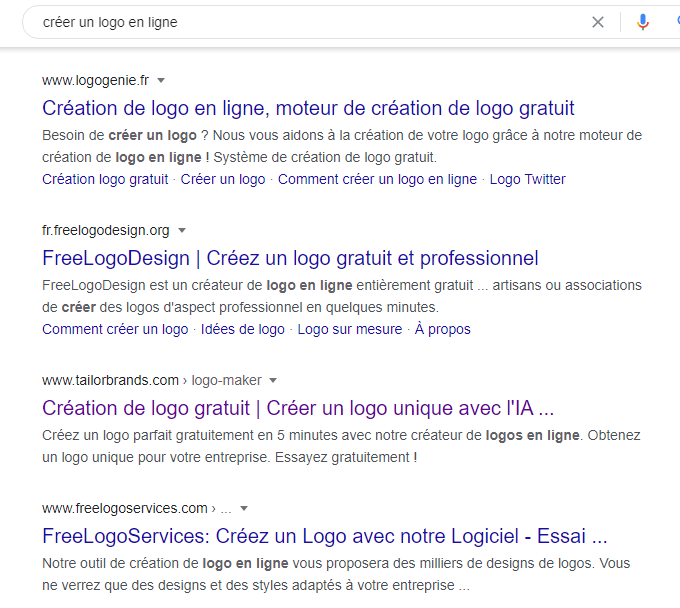
So, including keywords in this short snippet of HTML code will draw more attention to your page when a user searches for a particular phrase. And that is a substantial benefit.
2.4. Use rich snippets to enrich your meta description
The structured data is a very useful element to add to your metadata. Depending on the type of content you publish, factors such as ratings, price and publication date can determine whether or not a user will click through to your site.

So always use rich snippets to make your meta description even better and more detailed for web users
If you are using WordPress, you can add the structured data to your results using the wordPress plugin – schema.org
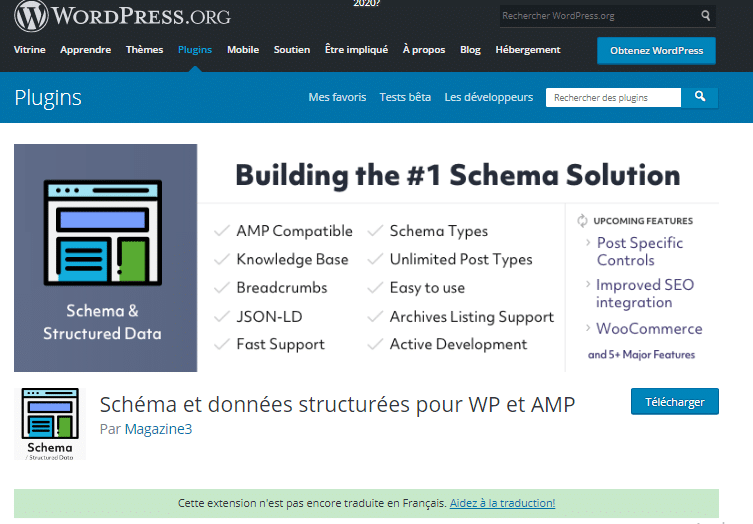
However, if you are not using WordPress, you can use thegoogle Markup Wizard to guide you through the process of adding rich snippets to your pages.
2.5. Make sure your meta description is unique
Please make sure that the meta description tag created for each page is unique, as duplicate tags can lead to serious problems of duplicate content
You can use the Screaming Frog SEO to detect them
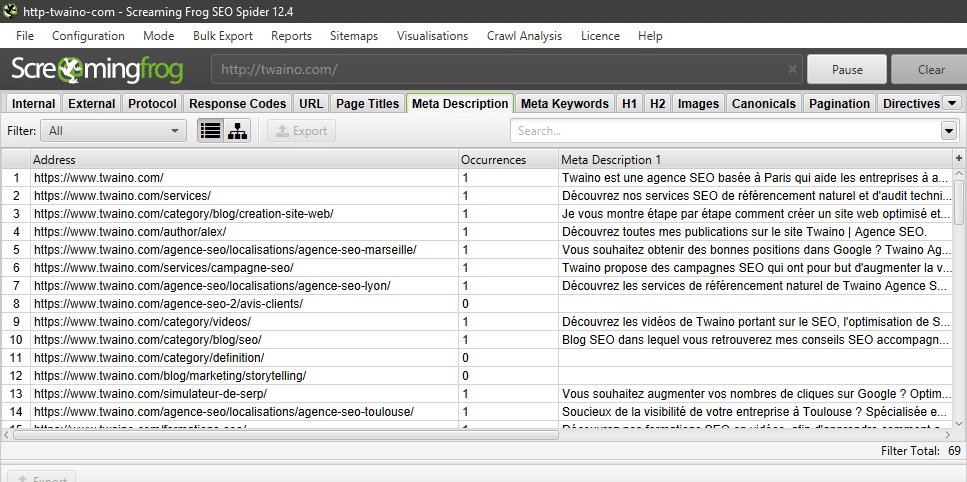
But in case you have detected the duplicate meta descriptions, how to fix them?
It’s best to rewrite them or get rid of them completely. In the short video below, Matt Cutts explained that it is better to forget them than to repeat them on the pages
As mentioned above, Google will automatically generate it for you when you don’t. In some cases, this can sometimes be the best solution.
Chapter 3 Meta description – How to manage it on large websites and how does it work on social networks?
3.how to manage meta descriptions on large websites?
It is easy to define meta description tags for a few pages such as newspapers or online blogs
Articles are handwritten, so writing an extra sentence or two for the meta description will certainly take less time for the author.

However, what is the best option for sites with hundreds or even thousands of URLs or pages, like large e-commerce sites.
First, the home page and each major landing page should have a unique description. For category and product pages, you can use a programmatically generated description (although use with caution).
Example of a programmatically generated description:
- ”Branded sandals from great retailers for the prices you like. At SOPHIE, we have blue sandals, pink sandals, and more.”
- ”Branded boots from major retailers for the prices you like. At SOPHIE, we have blue, beige, and other boots.”
In the examples above, category pages selling fashion include automatic and repeated information.
Why is it sufficient to generate a description per program for product pages?
Some product pages are important because they show up in SERPs and can generate new leads. In this case, it is important to write a unique and juicy meta description for these pages to increase the click-through rate.
However, for less important products, automatic generation of meta descriptions can be a feasible solution even though it is always better to do things manually. The reason is that it would be quite difficult to write tens of thousands of descriptions manually.
3.2. how do meta descriptions work in social media and how to configure them?
Do you have a business page on a social media platform? Are your followers or users sharing your content? If so, you also need to think about a social meta tag and an appropriate code snippet.
Why?
If you want to speak to your audience on Facebook or Twitter in a different way than your audience in organic search, you need to use different meta description variants in the snippets

But if you want to share the same information with users on all platforms, there’s no reason to spend time on description variation.
What is the optimal description length on Facebook and Twitter?
- On desktop:
On Twitter, it’s about 135 characters. A Facebook meta description depends on the length of the meta title. If the meta title is too long, the meta description won’t have much space left.
- On mobile devices:
It depends on the width of the mobile devices and the length of the meta title, just like on desktop computers. The meta description can be shortened or not displayed at all.
In my opinion, the shorter you keep it (less than 120 characters), the better it will be compatible with any platform and device.
Nevertheless, you don’t have to use these attributes and you can rely on the meta descriptions of search engines.
Let’s see how to create social network snippets (Facebook and Twitter) with HTML attributes:
3.2.1. Facebook
OpenGraph (OG) attributes for Facebook look like this:
property=”og:description”
content=”The meta description represents an essential element for social networks.”
>

This is very similar to the meta description defined in an HTML meta tag. It basically works the same way
Facebook finds the attribute and uses it in the post snippet so that readers have an idea of what the page is about before they click on it. For more details, read the tutorial on how to set up theopen Graph on Facebook.
3.2.2. Twitter
The description attributes for Twitter look like this:
name=”twitter:description”
content=”The meta description represents an essential element for social networks.”
>
Note: If the page has an OG attribute and no Twitter attribute, Twitter will read and use the OG tag. If you do not differ between the Facebook and Twitter audience, you do not need to use the Twitter attribute.
Chapter 4: Other questions asked about the meta description tag
4.1. What is a good meta description?
The meta description tag is a piece of HTML code in the header of a web page that describes the content of the page between 150 and 160 characters
It helps not only search engines, but also Internet users to understand the content of a page without having to click on it. It is usually displayed whenever the page appears in search engine results
4.2. What is the purpose of a meta description?
Search engines use this description in search results to inform visitors of the content of a page before they decide to click on it.
Generally, when well written, the meta description provides the following benefits:
- A good user experience;
- Increased click-through rate in SERPs;
- Bringing traffic from social networks.
4.3. When to use the meta description?
Matt Cutts explains here when you should use the meta description tag and when you don’t need it.
On every website, make sure you have defined a meta description tag on :
- The home page;
- Any important or potential landing page;
- Category pages for online stores;
- Blog posts;
- Contact pages.
Pages that do not show up in the SERPs do not need to have meta descriptions defined
4.4 How to write a good meta description?
- Focus on readers, not just search engines;
- Don’t exceed 160 characters for length;
- Use your main keyword naturally in the description;
- Start with a question, then show that you have the solution.
4.5. Where does the meta description appear?
This description appears below the title and URL of your page in the SERPs. To have visibility in Google, it must be well written and respect the normal length (140-160 characters).
4.6. Why does Google sometimes ignore my meta description and display another one?
When the meta description is missing, too long or too short, search engines can produce their own description
This is often less perfect, and does not guarantee the quality to encourage users to visit your website.
Ignorance is also caused by: The mismatch of your description to the user’s query or a poor quality of it.
4.7. Is it acceptable not to define a meta description?
You can leave this field empty, especially if you have a large website. Google will generate it for you.
But in this case, you should expect two situations. Google may display your page in the SERP with :
- A nice meta description for your page, full of important information using your well written content;
- A unattractive descriptiona not very attractive description, because Google has difficulty in finding a continuous and relevant content related to the searched keywords.
Indeed, no meta description defined on a page, no guarantee of the quality of its appearance.
4.8. How to modify the meta description?
- Connect to your WordPress site;
- Access the Yoast SEO plugin;
- Click on “Search Appearance” on the left side of the menu;
- Go to the archives at the top of the page;
- Edit the “Meta description” ;
- Finally, save the change.
4.9. How often does Google use the meta description?
An analysis on mobile and desktop search results shows that Google rewrites meta descriptions at a rate of 71% on mobile and 68% on computer. Based on this data, we can deduce that Google uses the defined meta description of a page about 30% of the time.
4.10. Is a meta description a ranking factor?
A meta description is not a direct ranking factor. Google webmaster John Mueller said this recently in a hangout to webmasters.
However, it can affect the CTR (Click Through Rate) of a page when it is well written. And if the CTR is a ranking signaland if CTR is a ranking signal, creating a good meta description would be an important task to get better rankings.
4.11. what if you don’t see your meta descriptions in the SERPs?
After editing or adding a meta description tag to an already indexed page, you will not immediately see the results in the SERPs. Usually, search engines take some time to crawl a website.
But if you want to speed up the process, use the Search Console for webmasters. In the Explorer section, click on Explore and let Google crawl your site. This way, the search engine will retrieve the page and send it to the index
The results will not be visible immediately and may take one or two days.
In summary
Basically, the meta description tag is important for the referencing of a web page. If it is well constructed, it can increase the click rate of a page, therefore more visitors and more new customers.
However, it is important to remember that the creation of a meta description is not mandatory in all cases, especially for ecommerce sites with a large number of product sheets.
Do you have any other questions or interesting experiences with the generation or use of meta descriptions?
Let me know in the comments below. I’m very curious to know what you think about this guide.
See you soon!

